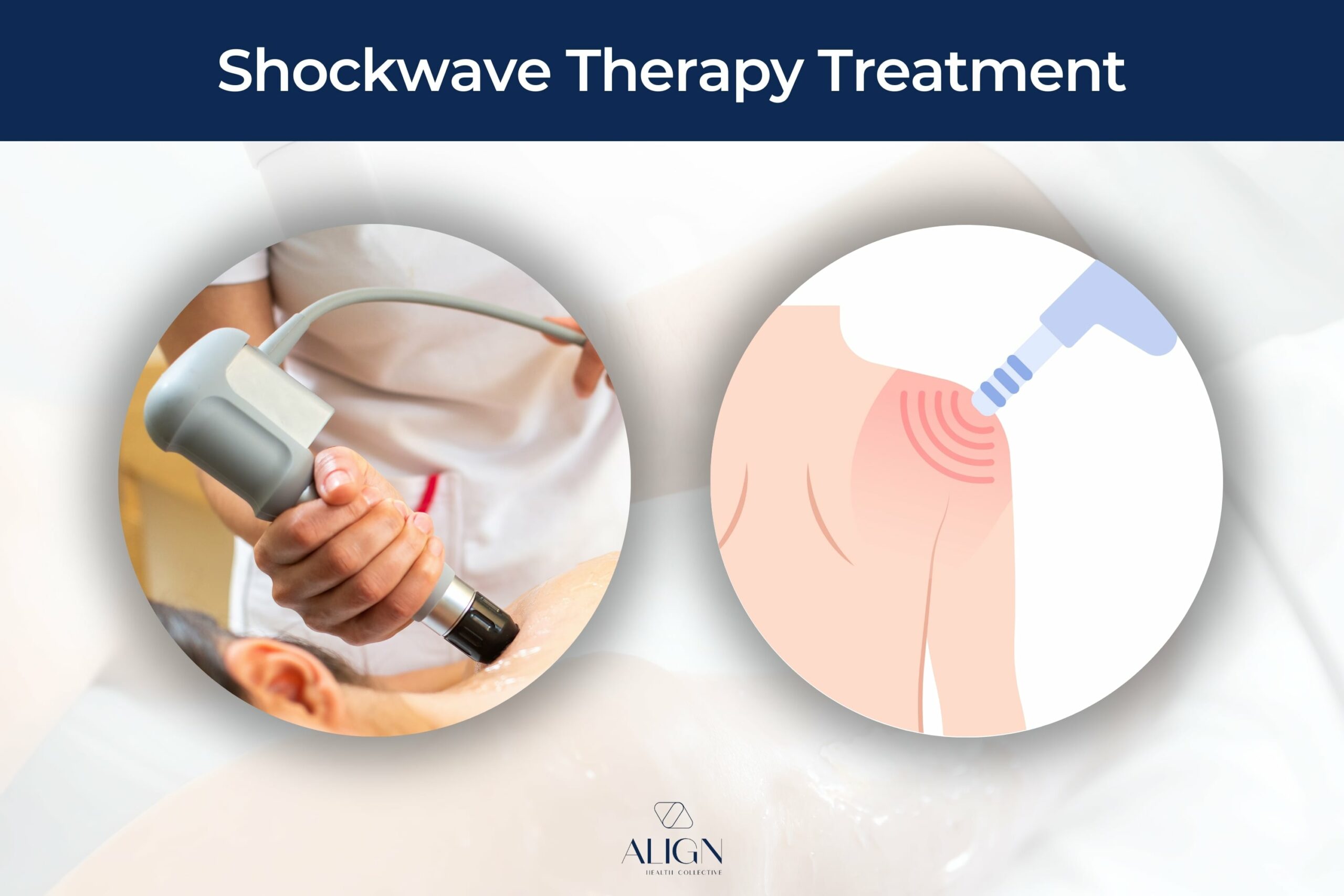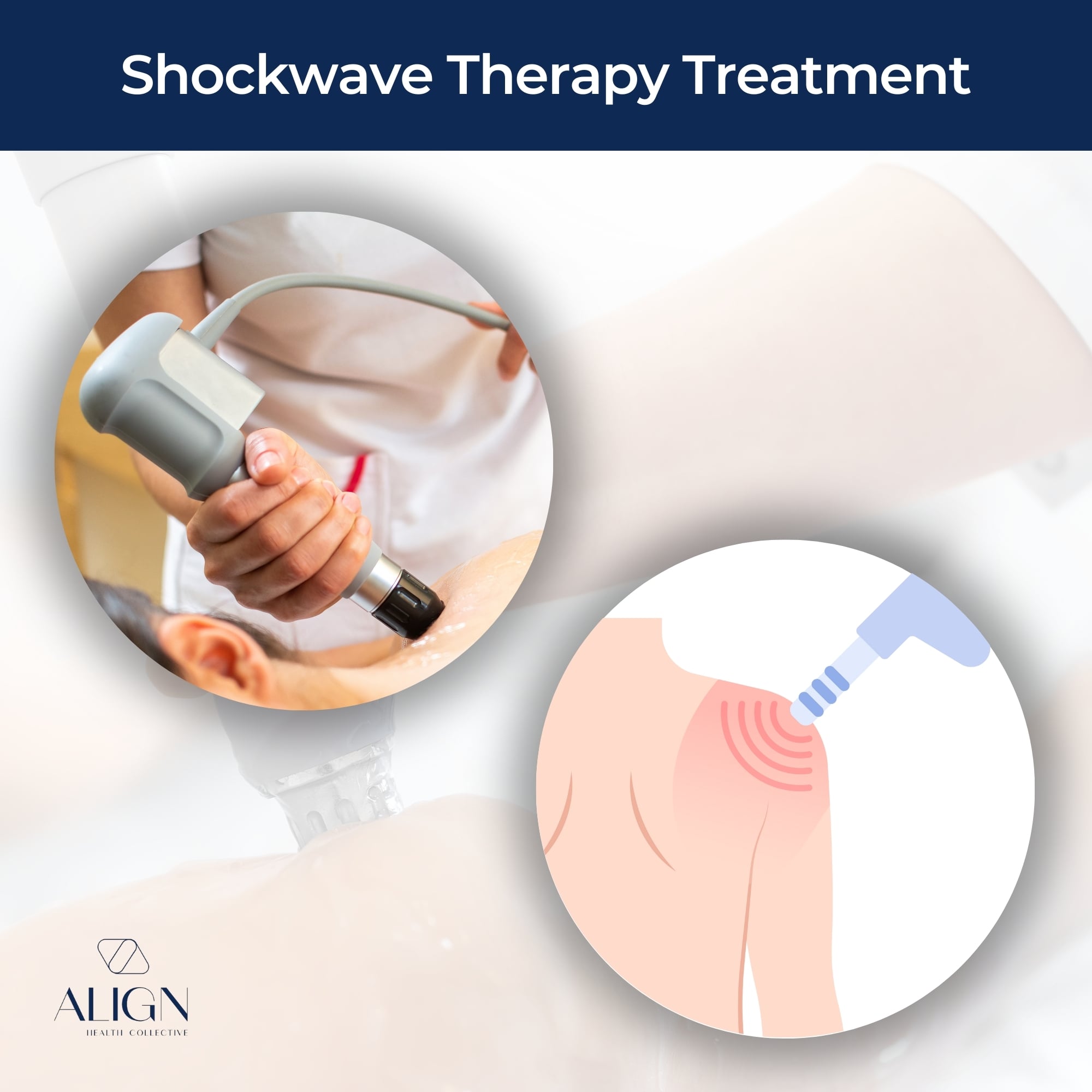Shockwave Therapy in Brisbane & Indooroopilly
– Non-Invasive Treatment for Pain Relief
What is Shockwave Therapy?
Shockwave therapy, a non-invasive treatment modality, is gaining traction in Brisbane as a revolutionary approach to pain relief and healing in various musculoskeletal conditions. Utilising high-energy sound waves, this therapy targets affected areas, promoting the body’s natural healing response. Especially effective in treating chronic pain, shockwave therapy offers an alternative to surgery, often reducing the need for invasive procedures.
Shockwave Therapy Treatment in Brisbane


How Does it Work?
Shockwave therapy is employed to treat conditions like plantar fasciitis, Achilles tendinopathy, and chronic heel pain. The therapy works by delivering radial pressure waves or acoustic waves to the affected area, enhancing blood flow and promoting tissue healing and regeneration. This process is instrumental in breaking down scar tissue, a common issue in chronic musculoskeletal conditions.
Benefits of Shockwave Therapy Treatment
Shockwave therapy in podiatry offers numerous benefits. It’s a safe and effective treatment option for various conditions, including chronic plantar fasciitis and Achilles tendon issues. Patients experience significant pain relief and improved mobility. Moreover, the therapy is a non-invasive alternative to surgical interventions, making it a preferred choice for many.
What Can It Treat?
Shockwave therapy is a versatile treatment option used in managing various podiatric and musculoskeletal conditions. Its effectiveness in alleviating pain and stimulating tissue regeneration makes it a sought-after therapy for a wide range of ailments. Below is a detailed list of specific conditions that can be effectively managed using shockwave therapy:
- Plantar Fasciitis: A leading cause of heel pain, characterised by inflammation of the plantar fascia ligament.
- Achilles Tendinopathy: Inflammation or irritation of the Achilles tendon, often found in athletes and runners.
- Tennis Elbow (Lateral Epicondylitis): A condition affecting the tendons attached to the outer part of the elbow, commonly seen in tennis players.
- Golfer’s Elbow (Medial Epicondylitis): Similar to tennis elbow but affecting the inner elbow tendons, prevalent in golfers and athletes.
- Jumper’s Knee (Patellar Tendinopathy): A condition marked by injury or inflammation of the patellar tendon, typically seen in athletes involved in jumping sports.
- Shoulder Tendinitis/Tendinopathy: Inflammation or irritation of the tendons in the shoulder region.
- Rotator Cuff Tendinopathy: A common cause of shoulder pain involving the rotator cuff tendons.
- Heel Spurs: Calcium deposits causing bony protrusions on the underside of the heel bone.
- Chronic Soft Tissue Injuries: These include a range of conditions affecting soft tissues like muscles, tendons, and ligaments.
- Shin Splints: Pain along the shinbone, often experienced by runners and athletes.
- Stress Fractures: Small cracks in bones, commonly in the lower leg and foot, due to overuse.
- Bursitis: Inflammation of the bursae, small fluid-filled sacs cushioning bones, tendons, and muscles near joints.
- Hip Pain: Including trochanteric bursitis and hip flexor tendinitis.
- Trigger Finger: A condition in which a finger gets stuck in a bent position and then snaps straight.
- Osteoarthritis Pain: Particularly knee osteoarthritis, where the therapy helps in pain reduction and mobility improvement.
Shockwave therapy’s non-invasive nature makes it an appealing treatment option for these conditions, especially for those seeking alternatives to surgical interventions.
Types of Shockwave Therapy Treatment
Extracorporeal Shockwave Therapy (ESWT)
Extracorporeal Shockwave Therapy (ESWT) is a sophisticated and targeted form of shockwave therapy, distinct for its method of generating high-energy shockwaves outside the body. These shockwaves are then precisely directed to the affected internal tissues. ESWT is particularly renowned for its ability to penetrate deeper into the tissue compared to other forms of shockwave therapy.
The shockwaves in ESWT are of higher intensity and are concentrated on a specific point, allowing for a more targeted approach. This makes ESWT highly effective for deep tissue disorders, providing significant relief in conditions like plantar fasciitis, Achilles tendon pain, and other deeper musculoskeletal issues.
Radial Shockwave Therapy
Radial Shockwave Therapy is another effective approach, using radial waves to target broader areas. This method is especially beneficial for treating superficial musculoskeletal conditions and is known for its ability to provide pain relief and stimulate the healing of soft tissues.
In contrast to Radial Shockwave Therapy, which disperses energy over a broader area and is generally used for superficial issues, ESWT’s focused energy penetrates deeper, making it a more suitable option for conditions located within deeper tissues. Radial Shockwave Therapy covers a wider area and is more suited for superficial musculoskeletal issues. Both therapies, however, are non-invasive and effective in promoting the body’s natural healing processes.
Shockwave Therapy Effectiveness
How Effective Is It?
The effectiveness of shockwave therapy is well-documented through various evidence-based studies. One such study has identified shockwave therapy as an effective and safe non-invasive treatment option for tendinopathies, which are conditions causing reduced mobility and pain in tendon movements. In this study involving 384 patients, those undergoing shockwave therapy showed a significant reduction in pain and improvements in both functionality and quality of life. These benefits were evident immediately after treatment and were sustained at a 4-week follow-up, indicating the therapy’s potential as a primary treatment choice due to its effectiveness and safety.
Many of our patients report significant pain reduction and improved functionality after just a few sessions as well. Depending on the severity of the condition, a treatment plan may include three to five sessions. Shockwave therapy has shown to be particularly effective when combined with other treatment modalities like physiotherapy or chiropractic care.
Frequently Asked Questions
What are the risks of shockwave therapy?
Shockwave therapy is generally safe, but like any medical treatment, it carries some risks. These may include mild bruising, swelling, pain, numbness, or tingling in the treated area. However, serious complications are rare.
Are there side effects of shockwave therapy?
Yes, there can be side effects, though they are typically minor and temporary. Common side effects include discomfort during treatment, skin reddening, and swelling at the treatment site. Most side effects diminish within a few days post-treatment.
Who should not use shockwave therapy?
Shockwave therapy is not recommended for certain individuals, including pregnant women, children, people with blood clotting disorders, individuals with nerve or circulation disorders, and those with infections or tumours in the targeted area.
How long do effects of shockwave therapy last?
The effects of shockwave therapy can vary. Many patients experience relief after the first or second treatment, but the full benefits are often realised after a few weeks. The long-term effects can last several months and can be maintained with lifestyle changes and follow-up treatments if needed.
How painful is shockwave therapy?
The level of pain experienced during shockwave therapy can vary, but it’s generally described as tolerable. Some patients may feel discomfort, similar to a mild flicking sensation, during the treatment. The intensity of the treatment can be adjusted to ensure patient comfort.
Is shockwave therapy covered by Medicare?
No, Medicare does not typically cover shockwave therapy for conditions like plantar fasciitis and tendinopathies, as it is often considered a non-essential treatment. However, coverage from other health insurance can vary, and it’s recommended to check with individual insurance providers for specific policy details.

Reviews
Michelle Rudolph
Whata wonderful well being team! passionate and commited to making you feel better, and extremely professional. A special thanks to Chalerm who first took my phone call. Chalerm was very caring and attentive to my questions. I have seen bot Hayden and Rys here and they have both helped my issues amazingly so thanks to you both is you are reading:-) I feel so much better only after a few visits and I have so much more bounce in my stride having Rys educate me on correct footwear suitable to my arch. Hayden has been wonderful giving me manipulation in the areas I need it, and showing me core strengthing exercises. Thank you to Nick who is always so lovely when I arrive to my appointment with a friendly chat before I go in for my appointments. Nick is always Happy and so couteous whixh is so impotant as the first person in contact with the clients. Thankyou again to all of you:-)
James Zois
Great service and efficient handling. Highly recommend! Thanks Chalerm
J. H. Zadegan
Good, methodical practitioners and a very responsive business owner, looking after the customers.
Rita Gucciardo
After having a sore hip and back for 2+ years, my doctor reccomended the team at Align under a medicare care plan, I saw Rhys the podiatrist for my orthotics and Andrew for some physio and I am now pain free. Thankyou boys for your excellent care and support!
Carol Prichard
Josh, one of the practitioners, gave a great service and relieved the pain in my toe. Heads up to Josh.